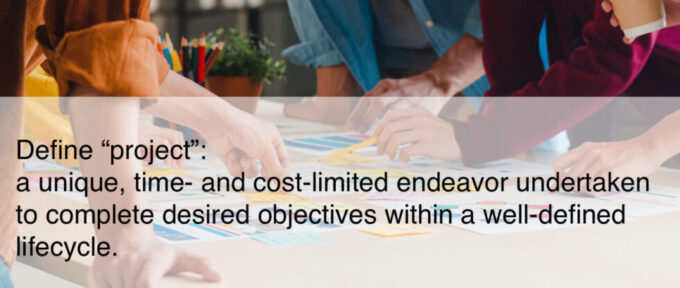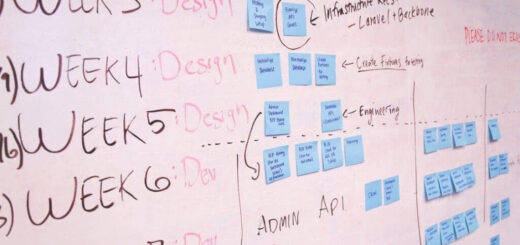
If you’re a project manager, developer, or anyone else who works on completing goals, then you’re familiar with the definition and essential characteristics of the project. However, project definition is often used in different contexts and can mean something different to each project management professional.
But one thing that everyone agrees on when it comes to the meaning of “project” is that every project initiative defines a final deliverable to be produced in a finite period and budget, unlike a continuous process.
An individual or organization involved in projects needs to understand how to solve the complexity of problems through a systematic management approach. In this article, we’ll define the terms “project” and “lifecycle,” describe the critical characteristics of a project, and explain how to distinguish a project from an activity.

What is a Project? – The Definition
Project is an excellent opportunity for organizations and individuals to achieve their business and non-business objectives more efficiently through implementing change. Projects help us make desired changes in an organized manner and reduce the probability of failure.
Projects differ from other types of work (e.g., process, task, procedure). Meanwhile, in the broadest sense, a project is defined as a specific, finite activity that produces a visible and measurable result under specific preset requirements.
It attempts to implement desired change in an environment in a controlled way. By using projects, we can plan and do our activities, for example:
- Build a garage.
- Run a marketing campaign.
- Develop a website.
- Organize a party.
- Go on vacation.
- Graduate a university with honors or whatever else we may wish to do.
A project is a temporary, unique, and progressive attempt to produce a tangible or intangible result (a unique product, service, benefit, competitive advantage, etc.). It usually includes a series of interrelated tasks planned for execution over a fixed period and within specific requirements and limitations such as cost, quality, performance, etc.
The Key Characteristics of a Project
As follows from the given definition, any project features these characteristics:
- Temporary. This fundamental characteristic means every project has a finite start and end. The start is when the project is initiated and its concept is developed. The end is reached when all project objectives have been met (or unmet if it’s evident that the project cannot be completed – then it’s terminated).
- Unique Deliverable(s). Any project aims to produce some deliverable(s) which can be a product, service, or another result. Deliverables should address a problem or need to be analyzed before the project start.
- Progressive Elaboration. With the progress of a project, continuous investigation and improvement become available, allowing more accurate and comprehensive plans. This fundamental characteristic means that successive iterations of planning processes develop more effective solutions to progress and develop long-term projects.
In addition to the listed characteristics, a conventional project is:
- Purposeful as it has a rational and measurable purchase
- Logical as it has a particular lifecycle.
- Structured as it has inter-dependencies between its tasks and activities.
- Conflict as it tries to solve a problem that creates some friction.
- Limited by available project resources.
- Risk as it involves an element of change with a negative impact.
Below are some examples of projects:
- Digging a well for the extraction of a natural resource in Nebraska
- Building a wooden house somewhere in Spain
- Developing a cloud-based marketing platform for startups
- Establishing a non-profit organization for COVID-19 relief and recovery efforts
- Renovating the kitchen
- Organizing a project meeting with critical stakeholders
- Running a marathon … (anything you don’t repeat often).
No matter how big or small your project is, you can benefit from using editable project templates ― pre-formatted, reusable outlines that are a starting point for planning new work. Templates enable you to set up to-do’s, budgets, project schedules, reports, and other formal documents without starting from scratch.
Project vs. Activity
If you need clarification on “project versus activity,” let us explain the differences in the following list.
- Project is an all-encompassing term that helps you organize multifaceted tasks and manage multiple resources.
- Activities are particular types of tasks categorized based on the kind of work involved, the purpose, and constraints.
- A project is a lifecycle event, while an activity is a discrete unit of time or task that complements the scope of project planning.
- Projects have tangible deliverables or products and measurable outcomes, unlike activities and routine operations that don’t.
- Projects are temporary, but activities are ongoing and continuous.
- Projects usually have a number of activities, while single tasks in an activity or multiple tasks within an activity do not represent a project.
- Activities are sequential and sequential activities can be part of a sub-project.
Project Work Breakdown Structure
In project management, the work breakdown structure (WBS) defines a deliverable-oriented hierarchical decomposition of all the essential work to be executed by the project team to accomplish the desired objectives and create the required deliverables. It’s made up of separate activities organized as packages or phases.
It’s an organized and systematic way of illustrating a project to increase clarity. The primary purpose of the WBS is to describe what work needs to be done and how it fits within the project context. Identifying the tasks for successful project completion is essential, so you can clearly understand what activities should be accomplished by specific dates.
A WBS serves as a basis for finding the critical path and developing a network diagram that captures the flow of work needed to accomplish the project objectives.

- Program – a broad, long-term objective that is often decomposed into a series of projects and sub-projects
- Task – an identifiable and measurable activity that creates a small unit of work for a related project
- Work package – a division of a project task
- Work unit – a division of work packages
Projects, programs, tasks, work packages, and units are the elements of the work breakdown structure or WBS. Often WBS is used to determine an activity-based hierarchy of projects regarding their deliverables and objectives.
A program includes several or larger projects. A larger project can be broken down into smaller interrelated sub-projects. Each can be divided into tasks that are decomposed into complementary activities or sub-tasks. A task includes a series of smaller goals that are monitored against milestones.
Project Lifecycle: Common Phases
The concept of the lifecycle is fundamental in project management. It describes a project’s phases over time, from initial launch to completion and termination.
The project lifecycle includes an organization’s activities to produce the final product. Therefore, these activities should be considered equally important and referred to as “steps” or “phases.”
The value of project lifecycle management is that it defines what key stakeholders should be focusing on:
- In each phase, progress the project to its subsequent development step.
- Associated risks and challenges.
- Effective leadership styles, team dynamics, and strategies support project success.
Depending on the company and the chosen method of project management, the project lifecycle can include these typical phases:
- Conducting a feasibility study is a phase meant to determine the viability of a project. The primary purpose of this phase is to identify the proposed project’s strengths, weaknesses, and opportunities.
- Establishing the project requirements — identifies functional and technical requirements for producing a desired outcome or benefit. Defining project acceptance criteria usually include in this step.
- Developing the project scope defines what has to be done for the product, who will do it, and how it will be done. This stage is also where the high-level project objectives should be defined.
- Creating the schedule and the budget — also called “project baseline” refers to the detail of the project timeline and the estimated budget, including dates and periods of each activity and the costs to be covered. It also includes time buffers for contingencies to avoid delays in the start or delivery of the product.
- Creating the project plan — planning, organizing, and scheduling the work assigned to a project is known as project planning. Its main aim is to ensure that the activities required to create and deliver a product are put in place following the allocated budget and deadline.
- Executing project work — it is also known as project implementation. The primary purpose of this phase is to ensure the completion of all activities and tasks following the project plan.
- Controlling and reporting — this phase consists of tracking progress, changing circumstances and risks, identifying issues, plus monitoring the work performed during project execution. It can notify managers in the case of any deviation from the plan.
Predictive and Iterative Project Lifecycles
Most project management lifecycles can be of two types: predictive and iterative.
The predictive lifecycle is suitable for projects where the deliverables should be completed within a predefined time frame and budget. For instance, here are the five phases of the predictive lifecycle (the waterfall methodology) according to The PMBOK Guide by the Project Management Institute (PMI):
- Initiation
- Planning
- Execution
- Monitoring and Control
- Closing
The predictive lifecycle is used in situations when you can estimate the average time required to complete every phase in your project. This makes it easy for managers to estimate the total time and cost that will be involved in completing the project successfully. However, this approach does not allow for identifying factors that might prevent you from achieving your goals on time and within budget.
The iterative lifecycle, sometimes called the spiral lifecycle, is suitable for situations when you cannot accurately estimate the time and cost to complete every phase or activity.
The iterative methodology is suitable for those types of agile projects that have to deal with uncertainties, frequent changes in requirements, and other unforeseeable problem-solving activities.
Below are the six standard stages of the iterative lifecycle (Scrum, Extreme Programming, Agile approach):
- Concept
- Inception
- Iteration
- Release
- Maintenance
- Retirement
Project Management in Business
Startups and mature companies widely use project management to complete complex tasks and business objectives. It is used for planning, organizing, and controlling business projects that guide an organization’s growth.
Business project management is a systematic approach to planning, organizing, and controlling the work of one or more people and divisions within an organization to achieve a specific business aim. It is usually carried out using project management tools and techniques to achieve a particular business goal.
A business project can be aimed at developing a new product or service that will either fill a gap in the market or create a unique niche for your company.
Say you want to develop a new generation of mobile phones, then it is an R&D project management task within your business operations.
Or, you want to build a computer program to speed up the process of resolving life-chat queries in your customer support department. Then you have to plan and organize its development as a software project.











